Who Controls the User Experience? AMD’s Carrizo Thoroughly Tested
by Ian Cutress on February 4, 2016 8:00 AM ESTBenchmark Results: Professional and OpenCL
Here are our results from our Professional and OpenCL tests. A reminder of our systems, including their graphics:
| System Overview | ||||
| µArch | APU + GPU | Memory | Channel | |
| HP Elitebook 745 G2 | Kaveri | A10 PRO-7350B (19W) R6, 384 SPs, 533 MHz |
8 GB | Dual |
| HP Elitebook 745 G3 | Carrizo | PRO A12-8800B (15W) R7, 512 SPs, 800 MHz |
4 GB | Single |
| Toshiba Satellite E45DW-C4210 |
Carrizo | FX-8800P (15W) R7, 512 SPs, 800 MHz |
8 GB | Single |
| HP Pavilion 17z-g100 |
Carrizo | A10-8700P (15W) R6, 384 SPs, 800 MHz |
8 GB | Single |
| Lenovo Y700 | Carrizo | FX-8800P (15W) R7, 512 SPs, 800 MHz R9 385MX, 512 SPs, 900-100 MHz |
16 GB | Single |
PCMark 08
PCMark08, developed by Futuremark, is a simple press play and run benchmarking tool designed to probe how well systems cope with a variety of standard tasks that a professional user might encounter. This includes video conferencing with multiple streams, image/file manipulation, video processing, 3D modelling and other tools. In this case we take the three main benchmark sets, Creative, Home and Work, and run them in OpenCL mode which aims to take advantage of OpenCL accelerated hardware. For fun we also put in the PCMark08 Storage workset.
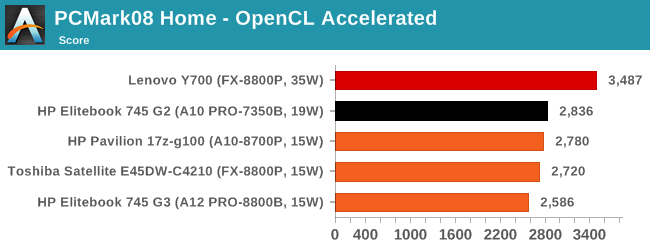
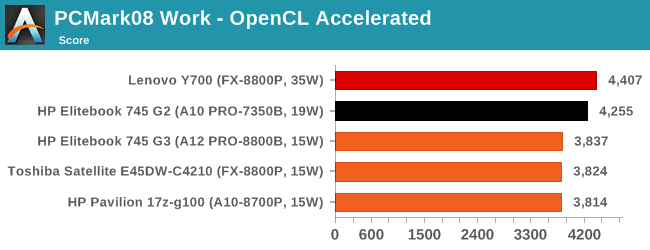
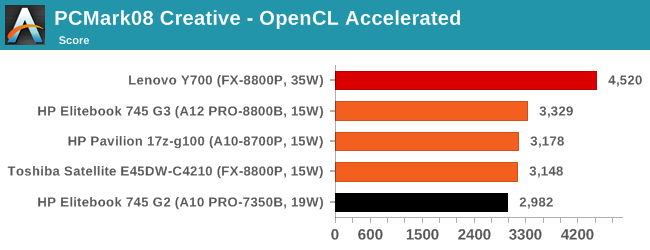
Both of the Home and Work tests show something starteling in the Kaveri system beating all the 15W Carrizo parts. This comes back to what we saw on WebXPRT on the last page – these workloads are very bursty in nature, requiring the system to wake up, run a small amount of work, and go back to sleep. It would seem that this requires a lot more effort from the Carrizo platforms than the Kaveri ones (perhaps by nature of the lower idle power draw starting point on Carrizo) which impacts time critical performance metrics.
If we take the CPU frequencies of the two Elitebook systems, starting with the 745 G2 (Kaveri)
Here the standard frequency tends to be in the 3300 MHz region, moving down to lower frequencies when more threads are needed. But for the 745 G3 (Carrizo):
Here the CPU frequency is obviously mostly at the 2500 MHz mark, sometimes bursting up to 3400 MHz (It’s actually more of a 2:1 split in favor of 2500 MHz).
You might argue that the temperature of the design might be to blame. Both Elitebooks are in the same chassis, so let us see:
(take note of the scales)
Here it shows the G2 wanting to stay below 60C, whereas the G3 is happy to go almost to 80C, albeit with an average temperature which is nearer 50C. This means that the G2 can arguably keep the higher frequencies for longer.
Just to weigh in on the other 15W Carrizo designs in the Toshiba Satellite and HP Pavilion:
In both cases, similar to the G3, the main frequency for the test is actually the lower 2500/2300 frequency, with the system moving up to the higher frequency state around a third of the time, rather than staying at the higher state and moving back down. This is what is causing the Kaveri system to win out in these sorts of workloads (though likely at a power penalty).
On the storage front, having a mechanical drive is a killer here.

Agisoft Photoscan
Photoscan is professional software that takes a series of 2D images (as little as 50, usually 250+) and 'performs calculations' to determine where the pictures were taken and if it can create a 3D model and textures of what the images are of. This model can then be exported to other software for touch-ups or implementation in physics engines/games or, as the reader that directed me to it, national archiving. The tool has four phases, one of which can be OpenCL accelerated, while the other three are a mix of single thread and variable thread workloads. We ran the tool in CPU only and OpenCL modes.
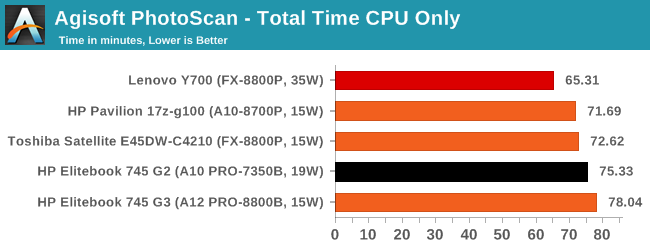
When pure CPU performance matters, having the higher thermal headroom matters most. But moving it to the OpenCL mode shows that those extra TDP points can matter a lot on load balancing:
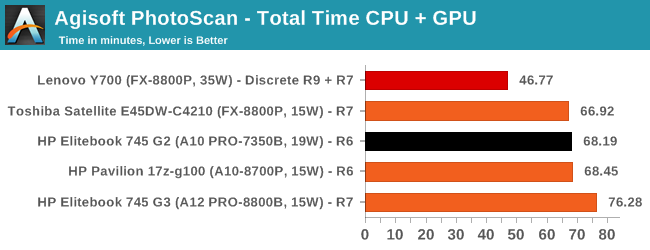
There are two things to note here. One, something seems to have gone very wrong with the G3, and I’m sure those numbers are erroneous and need to be re-run or the 4GB of memory is actually a hindrance here. The second is that the combination R7/R9 graphics in the Lenovo, despite not being in Crossfire, can both be used in OpenCL mode. This pushes a speed up of almost 30%.
Linux Bench
Linux Bench is a collection of Linux based benchmarks compiled together by ServeTheHome. The idea for this is to have some non-windows based tools that are easy enough to run with a USB key, an internet connection and three lines of code in a terminal. The tests in Linux Bench include standard synthetic compute, compression, matrix manipulation, database tools and key-value storage.
Unfortunately Linux Bench refused to run on any of the HP systems for relatively unknown reasons – the fact that it was all the HP models perhaps means that there is something firmware related which is causing the LiveCD to not boot properly. Nonetheless, the results are here for completeness.
| Linux Bench | ||
| Toshiba Satellite E45DW-C4210 (15W) |
Lenovo Y700 (35W) |
|
| C-Ray Hard Test / seconds | 365 | 267 |
| 7-Zip Compression MIPS | 5718 | 6110 |
| 7-Zip Decompression MIPS | 7320 | 9733 |
| NAMD (steps per time) | 1.72 | 2.46 |
| NPB MOPS (per sec per thread) | 365 | 321 |
| OpenSSL Sign | 220 | 296 |
| OpenSSL Verify | 13518 | 19465 |
| Redis 1 | 13210 | 12034 |
| Redis 10 | 41494 | 38760 |
| Redis 100 | 33445 | 31949 |






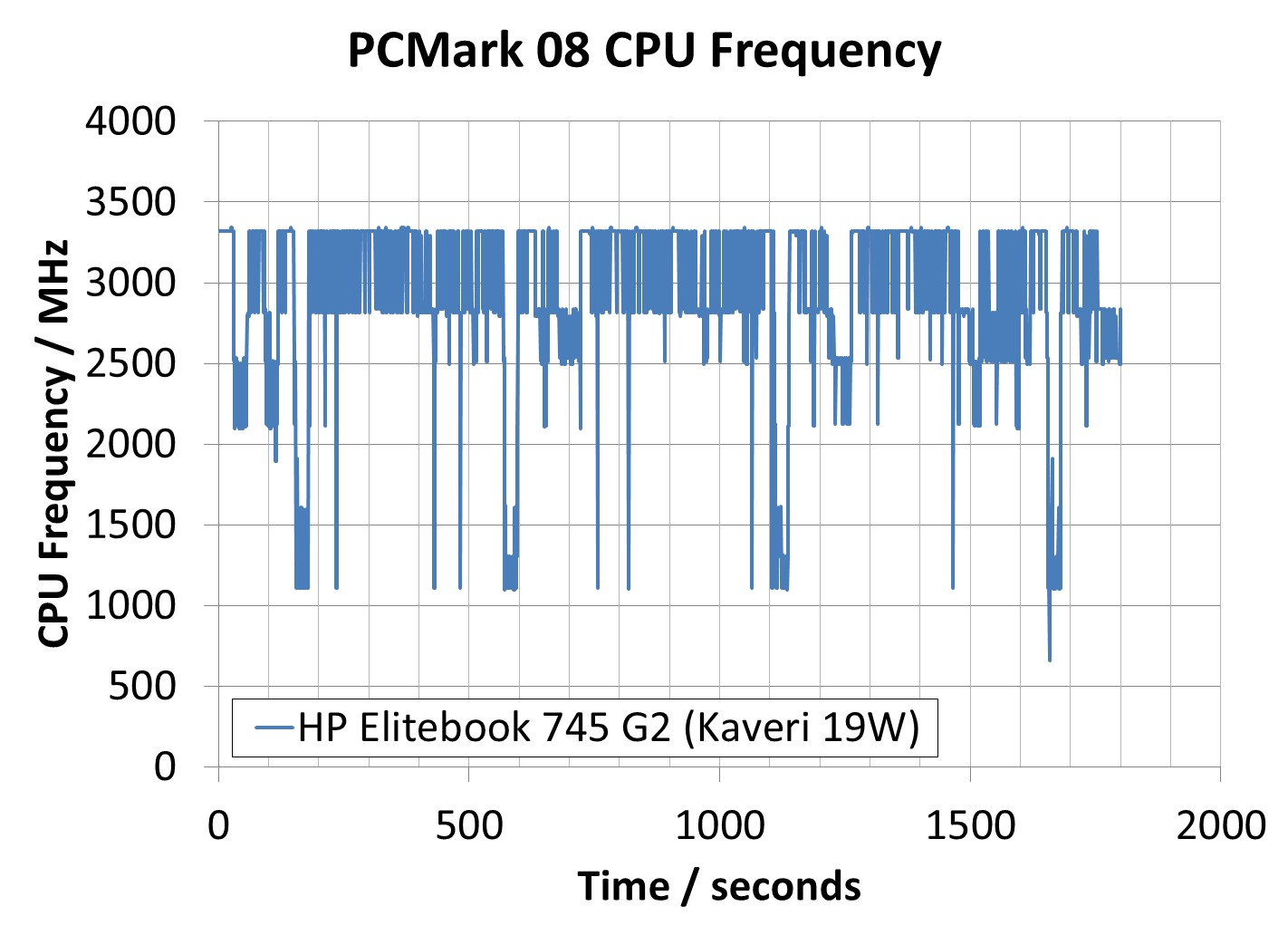

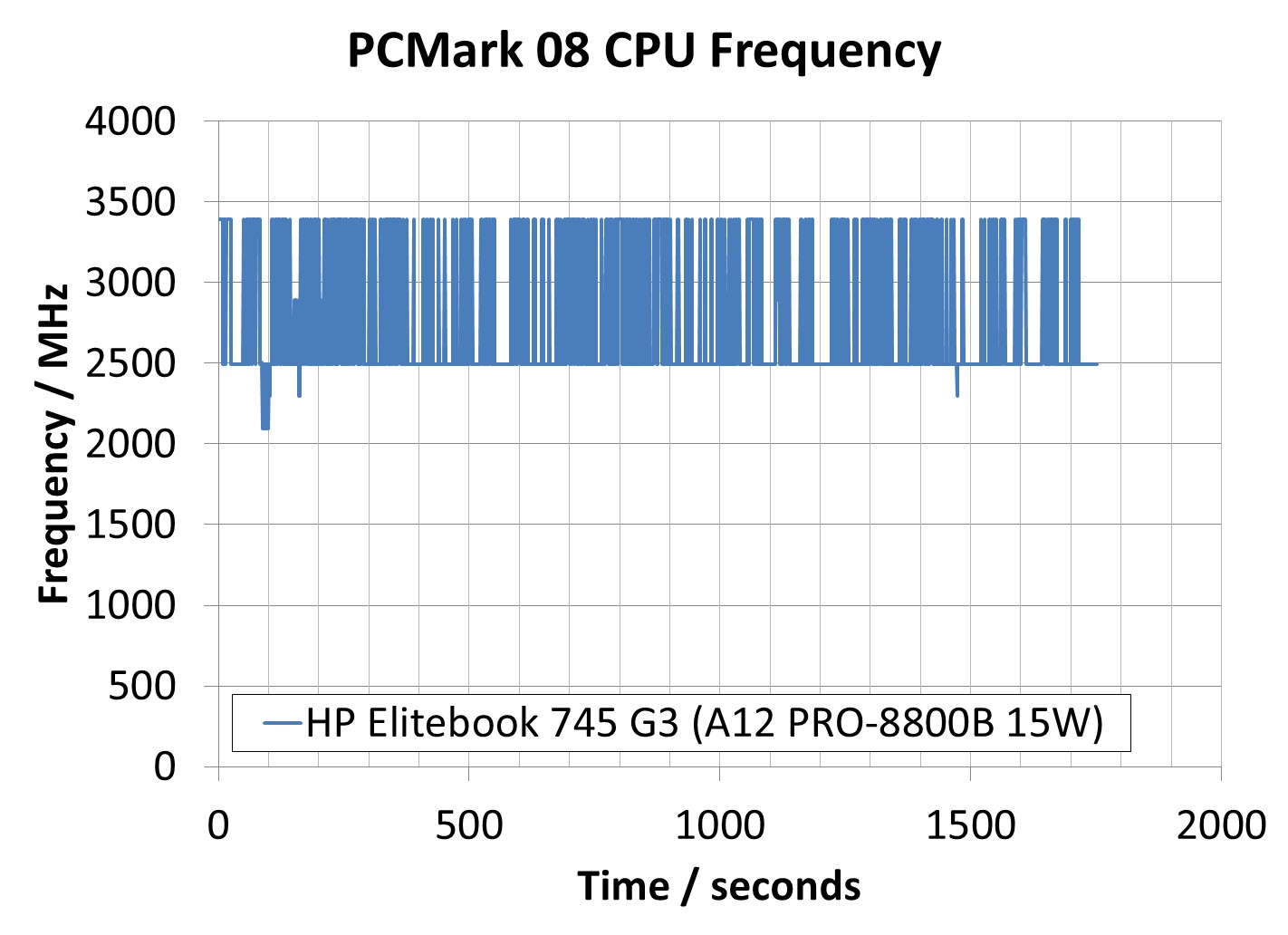
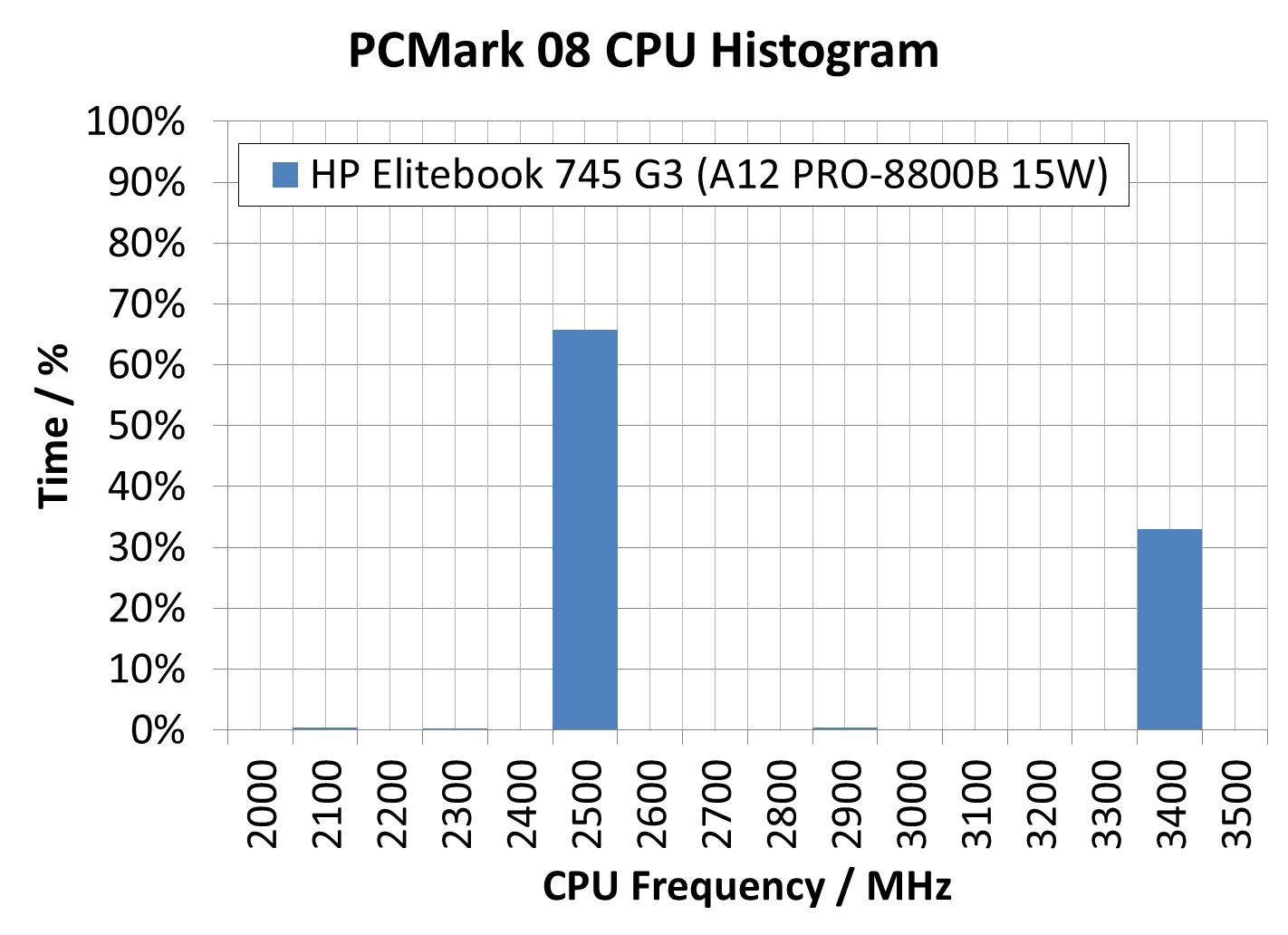

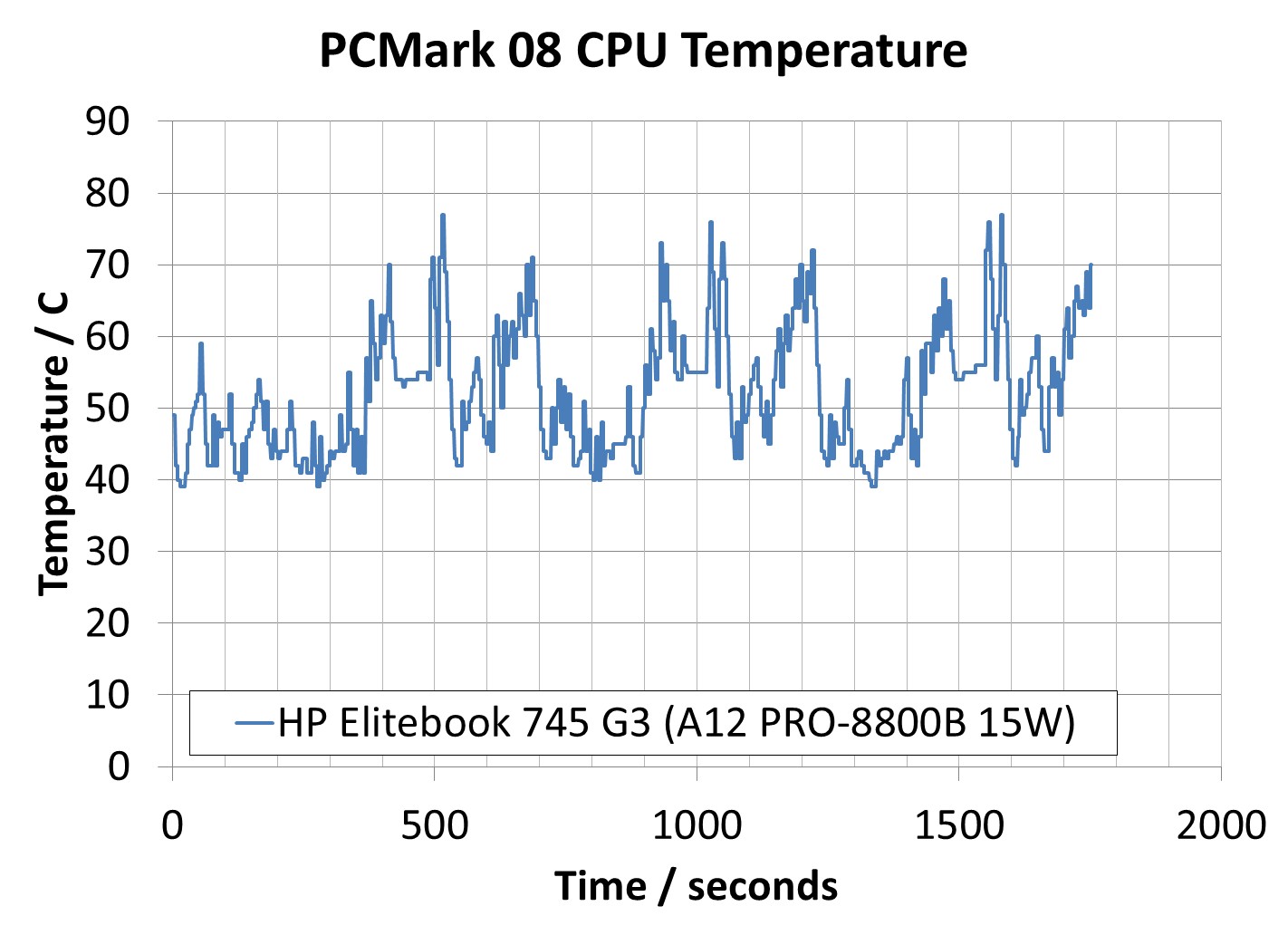










175 Comments
View All Comments
alexruiz - Friday, February 5, 2016 - link
Ian,What specific model of the Elitebook 745 G3 did you test?
You listed the QHD screen (2560 x 1440 IPS) but you also wrote that it came in at just under $700. Is this correct? The one that you received for $700 included the QHD screen?
Thanks
Anonymous Blowhard - Friday, February 5, 2016 - link
The link on the page goes to the T3L35UT#ABA, which is a 1080p screen. I'm guessing the spreadsheet and/or pricing is incorrect somehow.Ian Cutress - Friday, February 5, 2016 - link
I remember being told it was 700, though I may have misheard and perhaps they were speaking GBP. But AB is right, the larger screen is 1080p and more expensive.The HP website is surprising though - the UX on the website is crazy to find a product that isn't the latest and greatest. It is very difficult to find anything and you seem to pay a premium for speccing out a custom Elitebook. Trying to spec out the one I was given came to $1900 from a $1620 base, which clearly isn't right because the high end 'buy now' model was about $1120 with similar specifications.
http://goo.gl/5spQls
Anonymous Blowhard - Friday, February 5, 2016 - link
GBP certainly makes a lot more sense. The base USD$750 model on HP's site has an A8-8600B, 4GB of RAM, and a 500GB HDD. If you want to find a Carrizo system with an "awful user experience" there it is.Custom-building an HP business system from their site is also expensive for no reason other than "because we said so." They really want you to buy the mass-manufactured SmartBuy models, although you may have better luck with a custom unit (read: "reasonable pricing") if you buy from a 3rd-party reseller.
I would like to see some GPU benchmarks with a second stick of RAM added to the 745 G3 though. Single-channel memory gives integrated graphics the Tonya Harding treatment.
Intel999 - Sunday, February 7, 2016 - link
Another review of Carrizo in the HP 745 G3 showed a 30% improvement in gaming when the second stick of RAM was installed. It went from woefully behind Intel to just ahead of them after sufficient RAM was provided.It is remarkable that any OEM would damage their own reputation by putting out crap that is obviously intended to funnel sales to Intel.
Imagine an OEM putting out a model, let's call it HP100, and offering it with identical specs with the only difference being a Carrizo CPU vs. an I5 from Intel. Few if any, would notice a difference in performance in the real world, not talking benchmarks.
The OEM would have a $100 savings on the Carrizo version if not more. If they were to sell it for $50 less than the Intel version they would sell more and that extra $50 profit on the AMD machine would more than offset the "rebates" they are getting from Intel. So they could have a higher profit margin at a lower price point. Afterall, with all the Intel marketing you'd still have plenty of people opting for the Intel version with it's lower profit margin. Just not as many and overtime you could approach Intel and point out that you make more money off AMD machines and who knows, maybe for the first time in recent history the OEM would control how their company is run and Intel would say "I guess we can cut our price by $25" and then you would be making the same profit on both Intel and AMD machines since, of course, the OEM wouldn't pass that $25 to the customer.
They could still offer junk machines at lower price points. Fill em up with Celerons or whatever they wanted attached to HDDs, 4GB of RAM, and crap screens.
Surely, no OEM is still following the old Intel rebate plan that allowed Intel to determine the market share that the OEM is allowed to give AMD. Or, are they?
Lolimaster - Friday, February 5, 2016 - link
I hate HP store with all my might, back in the day I got better experience donwloading from japanese p2p's not knowing japanese and just using a simple guide.keeepcool - Friday, February 5, 2016 - link
Please, just dont let Toshiba make laptops, just DON'T.Sorry for the word, but Toshiba is a shit brand that deserves to die. All their laptops have cooling solutions that are badly designed from the start, and the they cut all the corners and go for paper thin 4mm heatpipes on top of deformed and pitted 1.5mm cooper plates that make poor contact with the dies, the fans are thin, the thermal paste is worse than toothpaste, just stop allowing them to disgrace AMD name.
HP is also guilty of this, after the disgrace that where the dv6 models almost no one in Portugal and a lot other countries ever want a laptop with AMD cpu or gpu, because DV6's are just know for being litteral toasters that crash and burned, yes part of that was due to lack of maintenance, but still, it left a very sour taste regard AMD/ATI equiped laptops.
Today only people with low monetary margins will go for an AMD laptop, because they are the cheapest ones, and even then HP and Toshibas just manage to make toasters out of 7 and 15Watts TDP, its like they actually spend time engineering them to became so hot with so little TDP's...
tipoo - Friday, February 5, 2016 - link
50.27 Wh, 3 cell Li-Po design, rated to 10.25 hours. Out of a 3.3GHz AMD APU.You know, HP, somehow, I don't believe you.
bluevaping - Friday, February 5, 2016 - link
Nice article. And I get the point of the article about OEM's and AMD. I mostly agree with Shadowmaster 625. But it would have been nice to see a dual channel memory test. The Elitebook supports it. Slap in the extra ram and test it. And try dual channel 1866 Ram too.tipoo - Friday, February 5, 2016 - link
Shame the Lenovo doesn't support dual graphics - any reason why, or will this be updated in drivers? Especially as the integrated one has the same number of SPs as the dedicated, it could add a lot to the power equation.